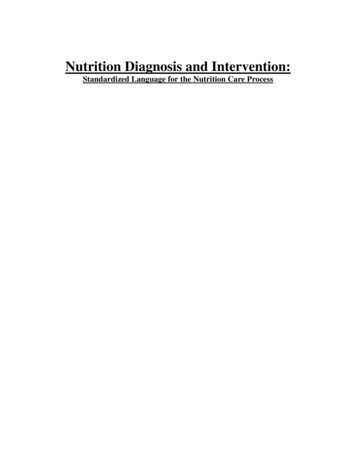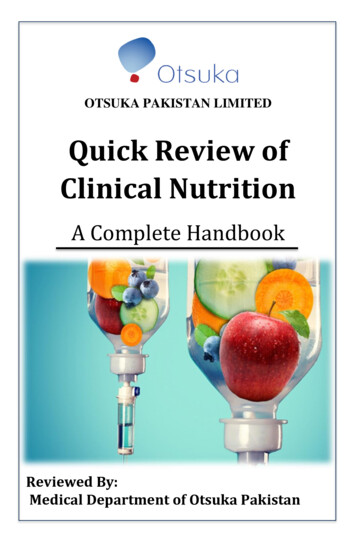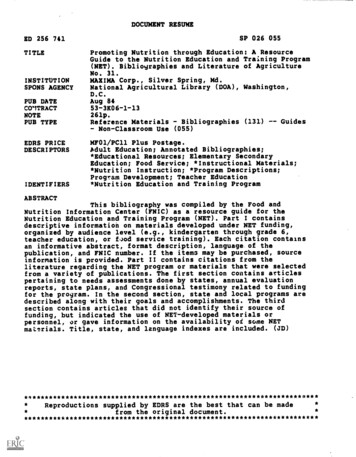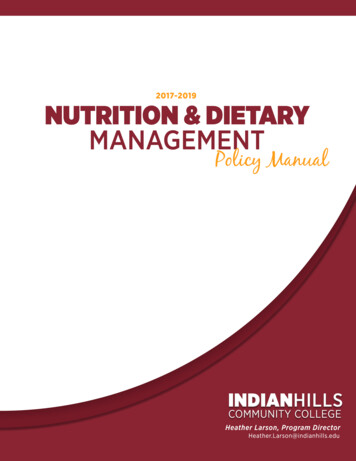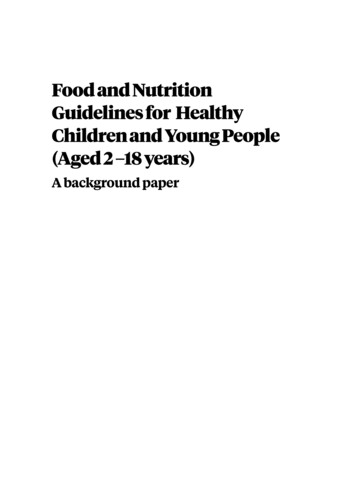
Transcription
Food and NutritionGuidelines for HealthyChildren and Young People(Aged 2 –18 years)A background paper
Citation: Ministry of Health. 2012. Food and Nutrition Guidelines for Healthy Childrenand Young People (Aged 2–18 years): A background paper. Partial revision February2015. Wellington: Ministry of Health.Published in July 2012Partial revision February 2015 (minor editorial changes)by the Ministry of HealthPO Box 5013, Wellington 6145, New ZealandISBN 978-0-478-44482-7 (print)ISBN 978-0-478-44483-4 (online)HP 5480This document is available at www.health.govt.nzThis work is licensed under the Creative Commons Attribution 4.0 International licence. In essence, youare free to: share ie, copy and redistribute the material in any medium or format; adapt ie, remix, transform and buildupon the material. Y ou must give appropriate credit, provide a link to the licence and indicate if changes were made.
ForewordThe health and wellbeing of our children and young people are extremely important, notonly for their lives now, but also for their futures and ultimately for the future of NewZealand. Good nutrition and adequate physical activity are key contributors to both healthand development. The Food and Nutrition Guidelines for Healthy Children and YoungPeople (Aged 2–18 Years): A background paper (2012) provides the information to educateand encourage children, young people and their families or whānau to follow healthylifestyles. This population health document aims to promote health while also preventingobesity and diet-related chronic diseases.These Guidelines have been developed from the update and amalgamation of the Foodand Nutrition Guidelines for Healthy Children (Aged 2–12 years): A background paper (1997)and the Food and Nutrition Guidelines for Healthy Adolescents: A background paper (1998).They aim to provide up-to-date, evidence-informed advice and technical information forhealth practitioners working with children and young people (aged 2 –18 years). Thesepractitioners include nurses, dietitians, doctors, nutritionists, health promoters andeducators.In recognition of the many factors that influence the food choices of children andyoung people, some new topics have been included. For example, new sections outlineconsiderations for selected population subgroups, the influence of environmental factorson food choice, and related topics such as physical activity and oral health.Dr Don MackieChief Medical OfficerClinical Leadership, Protection and Regulation Business UnitMinistry of HealthFood and Nutrition Guidelines for Healthy Children and Young People (Aged 2–18 years): A background paperiii
AcknowledgementsThe development of the Food and Nutrition Guidelines for Children and Young People (Aged2 –18 Years): A background paper has involved a number of stages. The final document isthe result of input that many individuals and organisations have provided throughout thisprocess.Initially the following stakeholders provided feedback on the proposed structure andcontent of the background paper: Dietitians New Zealand, the Paediatric Society of NewZealand, Public Health Nurses, Plunket, the Home Economics & Technology Teachers’Association of New Zealand, Te Hotu Manawa Māori, the Pacific Island Food and NutritionAdvisory Group (PIFNAG), the Asian Health Foundation and the Health SponsorshipCouncil.The Clinical Trials Research Unit at the University of Auckland prepared the initial draftof the Food and Nutrition Guidelines for Children and Young People: A background paperfor the Ministry of Health during 2009 and early 2010. Maria Turley wrote the draftbackground paper, with technical advice and input from Dr Cliona Ni Mhurchu, DelvinaGorton, Helen Eyles and Dr Andrew Jull. The initial draft then underwent external peerreview by Dr Clare Wall, Kate Sladden, Kathy Hamilton, Eruera Maxted (Part 9 on Māori),PIFNAG (Part 10 on Pacific peoples), Geeta Gala (Part 11 on Asian and ‘Other’ peoples) andthe Ministry of Agriculture and Forestry (topics related to food safety).Further development of the document by the Nutrition and Physical Activity Policy Teamat the Ministry of Health produced the Food and Nutrition Guidelines for Healthy Childrenand Young People (Aged 2–18 Years): A background paper – draft for consultation, which waspublished in October 2010. During the public consultation 44 submissions were receivedfrom individuals and organisations representing the public and personal health sector,industry, non-governmental organisations, academic and research sector, education andtraining sector and Crown agencies.Comments and recommendations (including some additional references) from thesubmissions were considered and further specialist input was sought to produce thefinal document. Tammy Kaiwai, Soana Muimuiheata and Pratibha Balu providedspecialist input to the meal plans in Appendix 5. Jenny Heyward, Rhonda Ackroyd andDr Jan Sinclair reviewed the allergy section in Part 12. Te Hotu Manawa Māori providedinformation for Part 9: Considerations for Tamariki and Rangatahi Māori and TheirWhānau.The Ministry of Health is grateful to all who contributed to this document, including thosewho made submissions during the public consultation process.ivFood and Nutrition Guidelines for Healthy Children and Young People (Aged 2–18 years): A background paper
ContentsForeword.iiiAcknowledgements. ivIntroduction.1Part 1: New Zealand Food and Nutrition Guidelines. 61.1 The New Zealand Food and Nutrition Guideline Statements, includingphysical activity. 61.2 Food groups and recommended serving sizes.71.3 Summary of food groups, serving sizes and recommended intakes. 9Part 2: Meal patterns of New Zealand children and young people.14Summary .142.1 Breakfast. 152.2 Lunch.162.3 Dinner. 172.4 Snacks. 172.5 High fat, sugar and salt foods.18Part 3: Growth and body size. 20Summary. 203.1 Growth. 213.2 Body size.253.3 Obesity. 263.4 Underweight. 30Part 4: Energy and nutrients.314.1 Introduction. 314.2 Energy.334.3 Carbohydrate.354.4 Dietary fibre.374.5 Fat.404.6 Protein. 464.7 Vitamin A. 484.8 Folate. 504.9 Vitamin D.524.10 Calcium. 564.11 Iodine. 594.12 Iron. 624.13 Selenium. 654.14 Sodium. 674.15 Zinc. 70Food and Nutrition Guidelines for Healthy Children and Young People (Aged 2–18 years): A background paperv
Part 5: Fluids.72Summary.725.1 Introduction.735.2 Recommended intake.735.3 Current levels of intake.745.4 Sources of fluid in the diet.74Part 6: The home environment and its influence on what children and youngpeople eat. 80Summary . 806.1 Introduction.816.2 Physical, sociocultural and economic factors within the home environment. 826.3 The dietary habits of young people.87Part 7: The wider environment and its influence on what families andindividuals eat.90Summary. 907.1 Introduction.917.2 The broader determinants of health and their influence on family/whānaudietary choices.917.3 The wider food environment. 92Part 8: Physical activity. 96Summary. 968.1 Introduction. 978.2 Health effects of physical activity. 978.3 Sedentary behaviour. 988.4 Physical activity recommendations. 988.5 Physical activity and sedentary behaviour levels in children and young people. 998.6 Increasing physical activity levels. 1008.7 Culture and physical activity. 1008.8 Types of physical activity. 1018.9 Nutrition requirements and physical activity.1028.10 Motivators for and barriers to physical activity.1038.11 Safety considerations.103Part 9: Considerations for tamariki and rangatahi Māori and their whānau.105Summary.1059.1 Introduction.1069.2 Nutrition and health indicators.1089.3 Concepts of health.1119.4 Traditional foods and cultural practices: kai from a historical perspective.1119.5 Working with tamariki and rangatahi Māori and their whānau. 112Part 10: Considerations for Pacific children, young people and their families. 115Summary. 11510.1 Introduction. 11610.2 Nutrition and health indicators. 11810.3 Concepts of health. 12110.4 Traditional foods and cultural practices. 122viFood and Nutrition Guidelines for Healthy Children and Young People (Aged 2–18 years): A background paper
10.5 Working with Pacific peoples. 123Part 11: Considerations for Asian and Other populations.125Summary. 12511.1 Introduction. 12511.2 Health status.12911.3 Nutrition and health indicators.13011.4 Traditional foods and cultural practices. 13211.5 Access to health care. 13211.6 Working with Asian and ‘Other’ populations. 132Part 12: Special dietary considerations.13412.1 Vegetarian eating.13412.2 Picky eating in children. 138Part 12.3 Food-related choking in young children aged 2–5 years. 13912.4 Food allergy.14212.5 Coeliac disease. 14712.6 Pregnancy and breastfeeding.148Part 13: Other issues.15013.1 Body image, disordered eating and eating disorders.15013.2 Oral health. 15513.3 Alcohol. 15813.4 Dietary supplementation.16013.5 Food safety. 16213.6 Food additives.16413.7 Intense sweeteners.16613.8 Caffeine.168Glossary. 172Abbreviations.182Appendix 1: New Zealand policy context.183Appendix 2: International policy context.185Appendix 3: Nutrient Reference Values for Australia and New Zealand.188Appendix 4: New Zealand–WHO growth charts.196Appendix 5: Three-day sample meal plans.199Appendix 6: Categories of household food security. 205Appendix 7: Summary of New Zealand studies. 206References. 208Index. 229Food and Nutrition Guidelines for Healthy Children and Young People (Aged 2–18 years): A background papervii
List of figuresFigure 1: Age and sex structure of the New Zealand population, 2006 Census. 2Figure 2: New Zealand policy context for the Food and Nutrition Guidelines for HealthyChildren and Young People (Aged 2–18 Years): A background paper. 3Figure 3: Body size for children and young people aged 2–14 years, 2006/07.25Figure 4: Body size for young people aged 15–19 years, 2006/07. 26Figure 5: Time (mean minutes per day) children and young people spend each day inmoderate- to vigorous-intensity physical activity, by age group and gender. 99Figure 6: Population age structure for the total population and Māori, 2006.107Figure 7: Population age structure for the total population and Pacific peoples, 2006.117Figure 8: Population age structure for the total population and Asian people, 2006. 127Figure 9: Population age structure for the total population and Middle Eastern, LatinAmerican and African people, 2006. 128Figure A9: Height, weight and head circumference, girls 1–5 years.196Figure A10: Height, weight and head circumference, boys 1–5 years. 197Figure A11: Weight–height to body mass index conversion chart.198List of tablesTable 1: Food groups, specific foods in each group, advice and serving size examples.10Table 2: Proportion (%) of males and females aged 15–18 years having high intakes perweek of high fat, sugar and/or salty foods and drinks.18Table 3: Mean height, weight and body mass index for New Zealand children andyoung people, 2006/07 . 25Table 4: Prevalence of obesity in children and young people.27Table 5: Median daily energy intake for children and young people. 34Table 6: Classification of major dietary carbohydrates.35Table 7: Median carbohydrate intake for children and young people. 36Table 8: Adequate intake for dietary fibre for children and young people. 39Table 9: Median dietary fibre intake for children and young people. 39Table 10: Dietary sources of omega-3, omega-6 and long-chain omega-3polyunsaturated fatty acids. 42Table 11: Adequate intake for fatty acids for children and young people. 43Table 12: Mean daily total fat and saturated fat intake for children and young people(as a percentage of total energy intake). 43Table 13: Dietary sources of fats. 45Table 14: Recommended dietary intake for protein for children and young people. 46Table 15: Median daily protein intake for children and young people. 47Table 16: Recommended dietary intake and upper level of intake for vitamin Afor children and young people. 48Table 17: Median daily vitamin A intake for children and young people. 49viiiFood and Nutrition Guidelines for Healthy Children and Young People (Aged 2–18 years): A background paper
Table 18: Recommended dietary intake and upper level of intake for folate forchildren and young people (per day). 51Table 19: Daily median folate intake for children and young people. 51Table 20: Recommended dietary intake and upper level of intake for calciumfor children and young people.57Table 21: Median calcium intake for children and young people. 58Table 22: Recommended dietary intake and upper level of intake for iodinefor children and young people per day. 60Table 23: Iodine status for children and young people.61Table 24: Recommended dietary intake and upper level of intake for iron forchildren and young people. 63Table 25: Median iron intake for children and young people. 63Table 26: Prevalence of iron deficiency and iron-deficiency anaemia for children andyoung people. 64Table 27: Recommended dietary intake and upper level of intake for seleniumfor children and young people. 66Table 28: Median selenium intake for children and young people. 66Table 29: Adequate intake and upper level of intake for sodium for children and youngpeople. 68Table 30: Lower-salt options for common foods. 70Table 31: Recommended dietary intake and upper level of intake for zinc forchildren and young people. 70Table 32: Median zinc intakes for children and young people. 71Table 33: Adequate intakes for fluids for children and young people.73Table 34: Average sugar and energy levels in fruit juice, flavoured milk, sugarydrinks and sports drinks.76Table 35: Estimated weekly family food costs for children and young people, 2010. 86Table 36: Average time children and young people spend each day onselected activities. 100Table 37: Some beneficial physical activities for children and young people. 101Table 38: Demographic information for the seven Pacific ethnic groups withthe largest population size in New Zealand.117Table 39: Demographic information for the seven Asian ethnic groups withthe largest population size in New Zealand.126Table 40: Characteristics and examples of foods that pose a high choking riskfor children under five years . 140Table 41: National history of food allergy and cross-reactivity between commonfood allergies.143Table 42: Perceptions of own body weight among young people, by ethnicityand gender. 151Table 43: Caffeine exposure estimates for New Zealand children and young people.169Table 44: Contributions of caffeine-containing foods to caffeine dietary exposurefor New Zealand children and young people.170Food and Nutrition Guidelines for Healthy Children and Young People (Aged 2–18 years): A background paperix
Table 45: Concentration of caffeine in a selection of New Zealand foodsand beverages.171Table A1: Estimated energy requirements for children and young people – males.189Table A2: Estimated energy requirements for children and young people – females.189Table A3: Nutrient reference values for children aged 2–3 years.190Table A4: Nutrient reference values for children aged 4–8 years. 191Table A5: Nutrient reference values for children and young people aged 9–13 years. 192Table A6: Nutrient reference values for young people aged 14–18 years. 193Table A7: Nutrient reference values for pregnancy.194Table A8: Nutrient reference values for lactation. 195Table A12: Sample three-day meal plan for three-year-old girl. 200Table A13: Sample three-day meal plan for six-year-old girl.
iv Food and Nutrition Guidelines for Healthy Children and Young People (Aged 2-18 years): A background paper Acknowledgements The development of the Food and Nutrition Guidelines for Children and Young People (Aged 2 -18 Years): A background paper has involved a number of stages.The final document is the result of input that many individuals and organisations have provided throughout this


